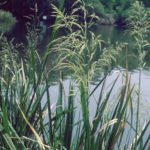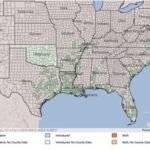Zizaniopsis miliacea
Illustration courtesy of University of Florida/IFAS Center for Aquatic and Invasive Plants. Used with permission.
What is Giant Cut Grass?
Physical Characteristics
- Large grass
Leaves:
- Flat
- Wide
- Up to 2.5 feet long
- Up to 1.5 inches wide
- Smooth surface
- Sharp edges
Flowers:
- Large
- Up to 2 feet long
- Branching
- Spreading
Fruit:
- Oval shaped
- Yellow
- Grains
Stem:
- Thick
- Up to 10 feet tall
Where Does it Grow?
USDA, NRCS. The PLANTS Database (http://plants.usda.gov). National Plant Data Team, Greensboro, NC 27401-4901 USA.
Giant cut grass can be found along the banks of ponds, lakes and rivers.
Pros and Cons of Giant Cut Grass
Giant cut grass provides a shelter and nesting area to wildlife. Wildlife also feed off of the seeds of giant cut grass. Submerged portions of all aquatic plants provide habitats for many micro and macro invertebrates. These invertebrates in turn are used as food by fish and other wildlife species (e.g. amphibians, reptiles, ducks, etc.). After aquatic plants die, their decomposition by bacteria and fungi provides food (called “detritus”) for many aquatic invertebrates.



